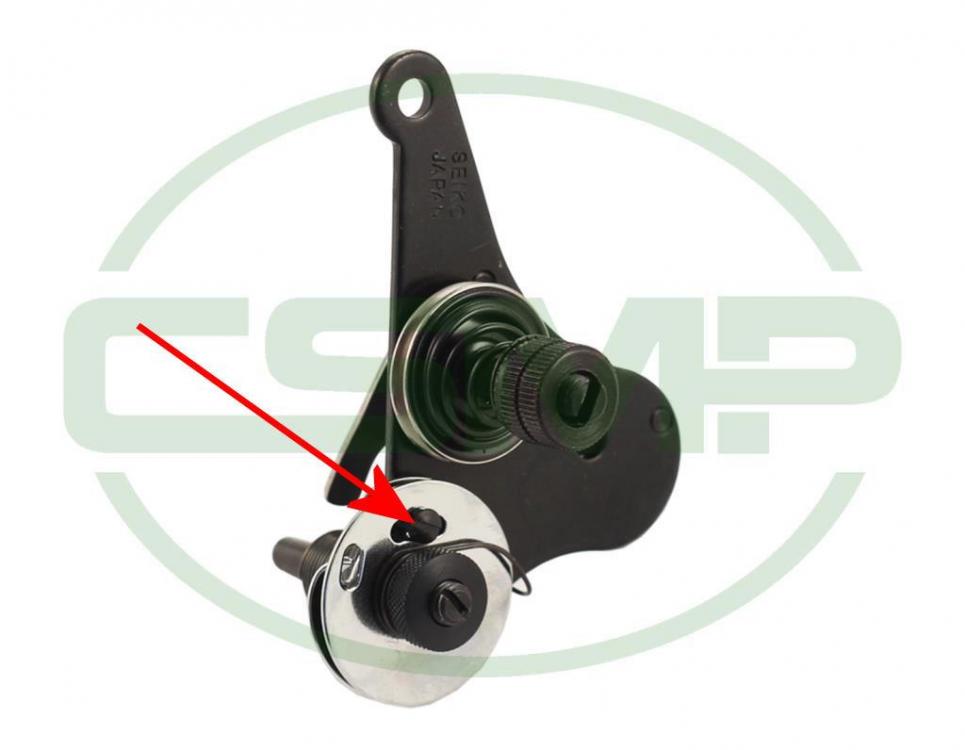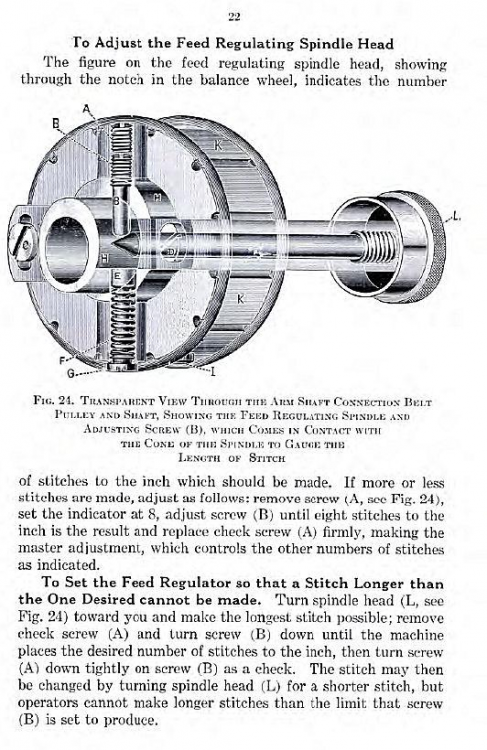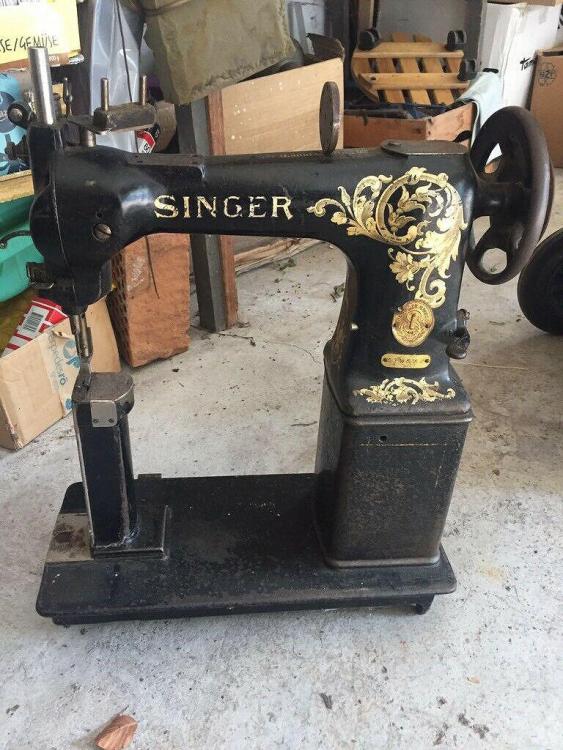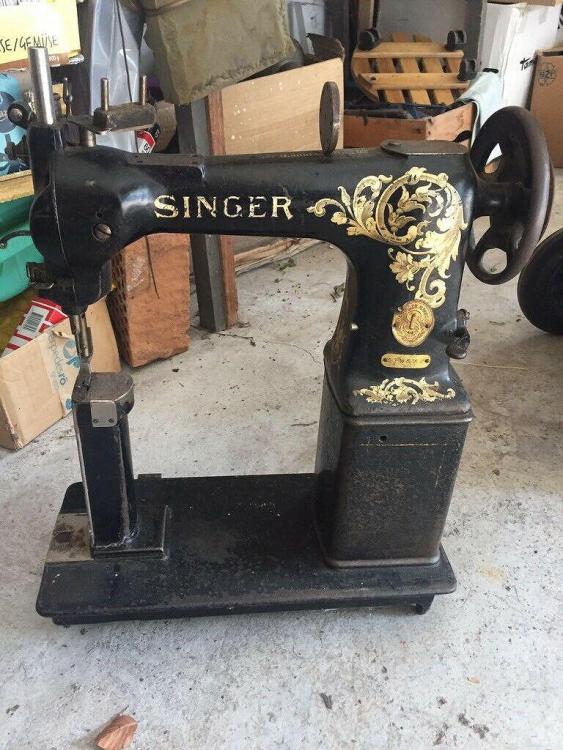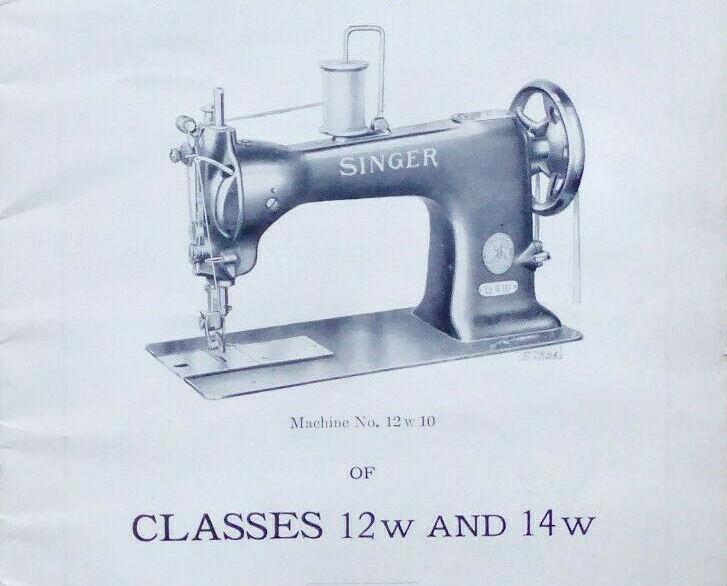-
Posts
5,713 -
Joined
-
Last visited
Content Type
Profiles
Forums
Events
Blogs
Gallery
Everything posted by Constabulary
-
I´m not sure but haven´t had you this problem before? If i recall correctly it was the slider on the backside of the machine which was hanging on the casting - or so. if not please post pictures of the head from all sides.
-
The 105-64 is a needle feed + drop feed only machine. Adler 205 triple feed / compound feed presser feet will most likely not work on this machine. You have to look for specific needle feed presser feet. But I yet haven´t seen any after market feet for the Adler 105 /205 needle feed machine. Most likely you have to buy Adler OEM feet. But you can install roller presser foot which slides onto the presser foot bar. The Singer 45K roller foot also works on Adler machines - in case you find one. Picture is an extract from a German Adler 5 Manual.
-
Pfaff 545 for $200 is a steal. I personally like the top loading bobbin on the 545 and it has a larger hook / bobbin. Personally I would keep the Pfaff because it will hold or even increase its value (you barely find them for less than $600--800 used). However - both are walking foot machines. If the 280 suits your needs and you do not need the larger bobbin keep the 280L. Only advantage on the 280 I see is that it takes Singer 111 type presser feet which are available very cheap - even dirt cheap some times. whereas Pfaff accessories are a lot more expensive. I would test / compare them for a while and then decide. You for sure can make some good bucks when you sell the 545 if the 280 is sufficient for what you are doing. Also do away with the Singer 31 if you don´t need it.
-

My old Durkopp is driving me up the wall!
Constabulary replied to toxo's topic in Leather Sewing Machines
It´s always a good advise to post pictures as soon as a problem occurs. Pictures tell more than 1000 words On the 1st pic I can see that the tension unit is not correctly assembled. The screw that holds the lower left "discs" in place is missing therefore it moved out of position and you most likely missed the small hook inside the disc when threading the machine. Pictures stolen from College Sewing UK - Dürkopp 239 and Singer 111 (and others brands) share the same tension unit. However - I never replaced the screw alone - not sure if spare screws are out there. Generic units are relatively cheap if you and to replace it. https://www.college-sewing.co.uk/store/240446-TENSION-COMPLETE-SINGER-111W Not sure what threading this screw has - maybe you have a short M3 (?) screw in you junk box and maybe an M3 tap... -
Thats an Adler 106-64 needle feed machine as it seems
-

Singer 112g141 restoration problems
Constabulary replied to Mizzy's topic in Leather Sewing Machines
Sorry that you have trouble with the parts but that sometime happens with after market parts from China. A good advise is buying OEM parts from Singer based machines made by SEIKO or JUKI. I had trouble with after market parts too so I´m always keen on figuring out if there are sewing machine brands with interchangeable parts. Beside JUKI and SEIKO I figured the older DURKOPP machines (not Durkopp-Adler) have a lot in common with Singer. College sewing often mentions when a parts are GENUINE (f.i. Seiko or Juki) - thats a good thing so the chance that these parts will fit is 99% or higher. I would not necessarily blame the parts dealer, they cannot check or test all the parts they get from "overseas sources" but I would expect that they at least "make it good" when a customer brings it to their attention and has a proof like the pictures you posted. I´d swallow the anger and buy a new bobbin case opener. It´s not worth the time and nerves. -

Singer 112g141 restoration problems
Constabulary replied to Mizzy's topic in Leather Sewing Machines
SIMANCO is Singer (SInger MANufacturing COmpany) Where are you buying your parts that a take up lever costs $120 I replaced one on my 212G141 (successor of your 1112G141) and bought it from College Sewing in the UK. Pretty sure its the same as on your machine: https://www.college-sewing.co.uk/store/267300-TAKE-UP-LEVER-SINGER-212W Parts number may be different but I´m confident it will fit. Why? Because the 111 and 211 share the same take up lever (see below link) and the 112 / 212 is the same but with 2 thread holes. https://www.college-sewing.co.uk/store/241518-TAKE-UP-LEVER-SINGER-211G This is the bobbin case opener if your machine has the same hook saddle as the 111 https://www.college-sewing.co.uk/store/10649-BOBBIN-CASE-OPENER-SEIKO-STW ============ EDIT: Gauge sets are cheap on Ebay - however you probably have to replace your presser foot bar because there are 2 types of gauge sets - a push in type (old type) and a screw in type. So if you have a push in type I would replace the presser foot bar too because the screw in types are easier to find and cheaper. Thats a future investment if you ever want to switch to a different gauge set. https://www.ebay.com/sch/14339/i.html?_from=R40&_nkw=gauge+set+1%2F4&_sop=15 This is the needle bar you need if you want to use a screw in gauge set https://www.college-sewing.co.uk/store/267267-NEEDLE-BAR-SINGER-212W-212G -

Help with very dirty Singer 111w155
Constabulary replied to PMCREATIONS's topic in Leather Sewing Machines
Dried old oil and dirt often looks like rust. Try a hot water and washing soda solution - you will be surprised how much gunk is coming off. Submerge the whole machine and use some brushes for cleaning the mechanics. If you have a compressor you can use a spray / wash gun to wash out the inside of the machine with this solution. Long bottle brushes can help cleaning the machine inside. You can also use kerosene / diesel or paint thinner - however - be careful when using inflammable fluids in the wash gun. It however is very effective but it also causes fumes you better do not inhale. BUT - it is effective - at least for what I´m doing. Depending on the overall condition my 1st step often is the washing soda solution followed by paint thinner. The paint thinner will wash out the water and soda remains and when its all dried I oil the machine. Always wear proper safety equipment! EDIT: I just recently discovered this stuff but haven´t tested it yet. https://www.amazon.co.uk/Koch-Chemie-Green-Universal-Cleaner/dp/B011OKX44S -

Adler 69-72/E 42 Needles - Help please!
Constabulary replied to TomSchell's topic in Leather Sewing Machines
So you know the needle system, the size and what tip you want - now what is the issue? -
Agree - hook is to high. Bobbin case opener is in a lower position than the bobbin case. I would loosen (not remove) the 2 set screws on the hook driving gear and push down the hook. Then tighten screws again.
-
when the machine was not in use for a while (maybe years?) I would generously oil the machine and not only on the oil ports also where moving parts come together (and there are a lot of moving parts). Let the oil maybe soak in maybe for a day (wicks are probably dry) and then remove access oil the next day. Oil will find its way and will drip off somewhere. I`m personally oiling the machine not before using I´m oiling when I´m done with the work so oil can soak in and I can wipe off access oil before I stark sewing so it will not "spill" when sewing.
-
don´t worry to much about the oil, plain Lilly White oil works on most sewing machines you seldom really need special oils. Sewing machines Co´s back then tried to sell their own "special" oil, Singer and Pfaff did this as well.
-
and it depends on the pulley - some clutch motors have pulleys with a tapered bore and to my best knowledge they do not fit on any servo.
-
Jep - also my 1st choice! I`m buying 90%+ of my parts there and bought all my servo motors from them as well. Hoping BREXIT never happens!
-
No offense but this offer has ZERO information. It´s like you say you have a glass of water for sale. 3 phase Durkopp Adler can be anything or nothing... What model is the machine, is it in working condition or not? Any accessories? How is the overall condition? Please post pictures and a price.
-

Singer 31-15 Tension breaks the thread
Constabulary replied to iknowit101's topic in Leather Sewing Machines
I like his Videos but I agree. However most of us are not professionals and when you don´t have machines to compare its not easy to figure out wether you are wrong or not - or if just the other guy is wrong. Best advise always is - READ THE FXCKING MANUAL However manuals often do not tell all the details but they are (in most cases) are the best source for 1st hand information! -
A Consew 227 is not a post bed machine and it often helps when you add pictures cause sewing machines sometimes come in variations. Furthermore - you have to be patient. We are all doing this for fun and not for money and not everyone is reading all sewing machine posts. I´m guessing your 227 is an early model with stitch length adjuster as used on the Singer 153 and w/o reverse - right? If so - turn the adjuster knob to the far right and pull it out (has a long thin rod with pointed tip). Installing is just the other way around. I have 3 Singer machines with this kind of adjuster so I know it works. This is an extract from a Singer manual - should give you an idea how to alter the stitch length settings.
-
It does not matter as long as it works. These multiple hole posts / thread guides are usually meant for getting a twist out of the sewing thread. However the "S" usually works well. If your thread is not causing problems I would just do the "S" (maybe top and bottom hole) if the thread has more twist I would use a few more holes - maybe like a double S.
-
Another Singer SV machine: 51W SV 2 As usual - no proper information available. I will pick up the machine next week and post a few more pictures then.
-
I´m looking for a manual (not parts list) for the earlier 51W post bed machines. In my Case a 51WSV2 - so pretty sure no one has manual for this specific SV machine. So I did some research and seems there are 2 types of 51w and the ones with subclass up to 30 (51W30 / 51W31) seem to be the earlier type with stitch length lever underneath the hand wheel and thread take up lever on the face plate side. So thats the type I would like to have a manual for. Its not that I need it for operating it (pretty sure I can thread it correctly just by experience) but I just like to have it and sometimes Singer manuals have included some good technical information for mechanics. I already figured the head part is pretty much identical with the Singer 12W / 14W class (at least some of them) I will pick up the machine next week - I have no idea if it works and how long the stitch length will be so I´m a bit excited A quick "teaser"
-

Experimental Nylon Gear Singer 29K
Constabulary replied to chrisash's topic in Leather Sewing Machines
looks like a fine toothed gear for the 29K5X series. I think you could increase the longevity when you replace all 3 pinions and the rack with nylon parts. -

How to thread a Pearson & Bennion A1
Constabulary replied to JohnShep's topic in Leather Sewing Machines
lovely machine - I once owned one. I unfortunately sold it because of space reasons. I hope you machine has all the parts - please post some pictures. I unfortunately cannot find the manual but maybe you can see enough detail on the pictures in the above thread. -
poor video sorry... too many thread hanging around and I cannot see what the actual top thread is and it is to fast to see the sewing cycle. Can you hand crank the machine (take off the V-belt) and watch the sewing cycle? when you start sewing do you hold the thread for the first 2 or 3 stitches? W/O knowing your machine and how it is threaded but this could happen when you loose the top tension (probably incorrectly threaded / wrong thread path?)
-

What's up with this thread I was given?
Constabulary replied to williaty's topic in Leather Sewing Machines
But you can buy thread from well known manufacturers - it may cost more but you for sure have less issues. It´s a good advice when you buy thread of a manufacturer who has a proper website and give you detailed technical information about their thread(s). Of course every dealer claims their thread is top quality but the key is that you know the "real" manufacturer - not the dealer or importer who probably but their own brand sticker on the thread cones. Just my 2 cents



